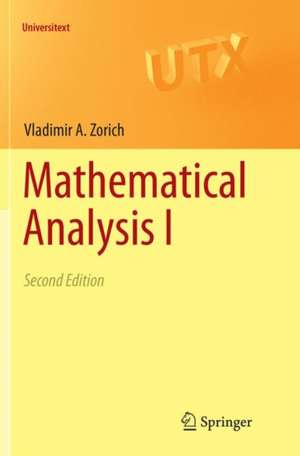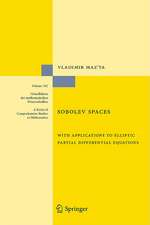Mathematical Analysis I: Universitext
Autor V. A. Zorich Traducere de Roger Cooke, Octavio Paniagua Taboadaen Limba Engleză Paperback – 25 apr 2018
The main difference between the second and first editions is the addition of a series of appendices to each volume. There are six of them in the first volume and five in the second. The subjects of these appendices are diverse. They are meant to be useful to both students (in mathematics and physics) and teachers, who may be motivated by different goals. Some of the appendices are surveys, both prospective and retrospective. The final survey establishes important conceptual connections between analysis and other parts of mathematics.
The first volume constitutes a complete course in one-variable calculus along with the multivariable differential calculus elucidated in an up-to-date, clear manner, with a pleasant geometric and natural sciences flavor.
| Toate formatele și edițiile | Preț | Express |
|---|---|---|
| Paperback (2) | 407.78 lei 6-8 săpt. | |
| Springer Berlin, Heidelberg – 25 apr 2018 | 407.78 lei 6-8 săpt. | |
| Springer Berlin, Heidelberg – 21 noi 2008 | 507.59 lei 6-8 săpt. | |
| Hardback (1) | 494.25 lei 6-8 săpt. | |
| Springer Berlin, Heidelberg – 11 mar 2016 | 494.25 lei 6-8 săpt. |
Din seria Universitext
- 13%
 Preț: 353.49 lei
Preț: 353.49 lei -
 Preț: 487.96 lei
Preț: 487.96 lei - 15%
 Preț: 543.75 lei
Preț: 543.75 lei -
 Preț: 418.67 lei
Preț: 418.67 lei - 20%
 Preț: 628.22 lei
Preț: 628.22 lei -
 Preț: 322.62 lei
Preț: 322.62 lei - 17%
 Preț: 364.82 lei
Preț: 364.82 lei -
 Preț: 634.38 lei
Preț: 634.38 lei - 17%
 Preț: 427.32 lei
Preț: 427.32 lei - 13%
 Preț: 355.52 lei
Preț: 355.52 lei - 17%
 Preț: 431.50 lei
Preț: 431.50 lei - 19%
 Preț: 429.21 lei
Preț: 429.21 lei - 19%
 Preț: 393.81 lei
Preț: 393.81 lei -
 Preț: 360.08 lei
Preț: 360.08 lei -
 Preț: 358.44 lei
Preț: 358.44 lei - 13%
 Preț: 389.95 lei
Preț: 389.95 lei -
 Preț: 465.61 lei
Preț: 465.61 lei -
 Preț: 371.99 lei
Preț: 371.99 lei - 15%
 Preț: 497.22 lei
Preț: 497.22 lei - 15%
 Preț: 737.46 lei
Preț: 737.46 lei - 17%
 Preț: 394.41 lei
Preț: 394.41 lei - 15%
 Preț: 509.58 lei
Preț: 509.58 lei - 17%
 Preț: 427.68 lei
Preț: 427.68 lei - 8%
 Preț: 495.44 lei
Preț: 495.44 lei - 17%
 Preț: 364.57 lei
Preț: 364.57 lei - 17%
 Preț: 368.15 lei
Preț: 368.15 lei -
 Preț: 396.55 lei
Preț: 396.55 lei - 15%
 Preț: 553.33 lei
Preț: 553.33 lei - 17%
 Preț: 365.35 lei
Preț: 365.35 lei -
 Preț: 356.78 lei
Preț: 356.78 lei -
 Preț: 673.45 lei
Preț: 673.45 lei - 17%
 Preț: 426.76 lei
Preț: 426.76 lei - 20%
 Preț: 569.56 lei
Preț: 569.56 lei -
 Preț: 372.87 lei
Preț: 372.87 lei -
 Preț: 319.07 lei
Preț: 319.07 lei -
 Preț: 379.86 lei
Preț: 379.86 lei -
 Preț: 445.88 lei
Preț: 445.88 lei -
 Preț: 382.36 lei
Preț: 382.36 lei - 15%
 Preț: 533.72 lei
Preț: 533.72 lei - 15%
 Preț: 496.02 lei
Preț: 496.02 lei - 15%
 Preț: 474.82 lei
Preț: 474.82 lei -
 Preț: 389.70 lei
Preț: 389.70 lei -
 Preț: 484.08 lei
Preț: 484.08 lei - 15%
 Preț: 643.48 lei
Preț: 643.48 lei -
 Preț: 415.02 lei
Preț: 415.02 lei - 15%
 Preț: 602.25 lei
Preț: 602.25 lei - 20%
 Preț: 510.24 lei
Preț: 510.24 lei - 15%
 Preț: 588.37 lei
Preț: 588.37 lei -
 Preț: 381.59 lei
Preț: 381.59 lei
Preț: 407.78 lei
Nou
Puncte Express: 612
Preț estimativ în valută:
78.03€ • 83.44$ • 65.06£
78.03€ • 83.44$ • 65.06£
Carte tipărită la comandă
Livrare economică 18 aprilie-02 mai
Preluare comenzi: 021 569.72.76
Specificații
ISBN-13: 9783662569559
ISBN-10: 3662569558
Pagini: 616
Ilustrații: XX, 616 p. 66 illus. in color.
Dimensiuni: 155 x 235 mm
Greutate: 0.88 kg
Ediția:Softcover reprint of the original 2nd ed. 2015
Editura: Springer Berlin, Heidelberg
Colecția Springer
Seria Universitext
Locul publicării:Berlin, Heidelberg, Germany
ISBN-10: 3662569558
Pagini: 616
Ilustrații: XX, 616 p. 66 illus. in color.
Dimensiuni: 155 x 235 mm
Greutate: 0.88 kg
Ediția:Softcover reprint of the original 2nd ed. 2015
Editura: Springer Berlin, Heidelberg
Colecția Springer
Seria Universitext
Locul publicării:Berlin, Heidelberg, Germany
Cuprins
1 Some General Mathematical Concepts and Notation.- 2 The Real Numbers.- 3 Limits.- 4 Continuous Functions.- 5 Differential Calculus.- 6 Integration.- 7 Functions of Several Variables.- 8 Differential Calculus in Several Variables.- Some Problems from the Midterm Examinations.- Examination Topics.- Appendices.- References.- Subject Index.- Name Index.
Recenzii
“This is a thorough and easy-to-follow text for a beginning course in real analysis … . In coverage the book is slanted towards physics (mostly mechanics), and in particular there is a lot about line and surface integrals. … Will be popular with students because of the detailed explanations and the worked examples.” (Allen Stenger, MAA Reviews, maa.org, May, 2016)
Notă biografică
VLADIMIR A. ZORICH is professor of mathematics at Moscow State University. His areas of specialization are analysis, conformal geometry, quasiconformal mappings, and mathematical aspects of thermodynamics. He solved the problem of global homeomorphism for space quasiconformal mappings. He holds a patent in the technology of mechanical engineering, and he is also known by his book “Mathematical Analysis of Problems in the Natural Sciences”.
Textul de pe ultima copertă
VLADIMIR A. ZORICH is professor of mathematics at Moscow State University. His areas of specialization are analysis, conformal geometry, quasiconformal mappings, and mathematical aspects of thermodynamics. He solved the problem of global homeomorphism for space quasiconformal mappings. He holds a patent in the technology of mechanical engineering, and he is also known by his book Mathematical Analysis of Problems in the Natural Sciences .
This second English edition of a very popular two-volume work presents a thorough first course in analysis, leading from real numbers to such advanced topics as differential forms on manifolds; asymptotic methods; Fourier, Laplace, and Legendre transforms; elliptic functions; and distributions. Especially notable in this course are the clearly expressed orientation toward the natural sciences and the informal exploration of the essence and the roots of the basic concepts and theorems of calculus. Clarity of exposition is matched by a wealth of instructive exercises, problems, and fresh applications to areas seldom touched on in textbooks on real analysis.
The main difference between the second and first English editions is the addition of a series of appendices to each volume. There are six of them in the first volume and five in the second. The subjects of these appendices are diverse. They are meant to be useful to both students (in mathematics and physics) and teachers, who may be motivated by different goals.
Some of the appendices are surveys, both prospective and retrospective. The final survey establishes important conceptual connections between analysis and other parts of mathematics. The first volume constitutes a complete course in one-variable calculus along with the multivariable differential calculus elucidated in an up-to-date, clear manner, with a pleasant geometric and natural sciences flavor.
“...Complete logical rigor of discussion...is combined with simplicity and completeness as well as with the development of the habit to work with real problems from natural sciences. ” From a review by A.N. Kolmogorov of the first Russian edition of this course
“...We see here not only a mathematical pattern, but also the way it works in the solution of nontrivial questions outside mathematics. ...The course is unusually rich in ideas and shows clearly the power of the ideas and methods of modern mathematics in the study of particular problems....In my opinion, this course is the best of the existing modern courses of analysis.” From a review by V.I.Arnold
This second English edition of a very popular two-volume work presents a thorough first course in analysis, leading from real numbers to such advanced topics as differential forms on manifolds; asymptotic methods; Fourier, Laplace, and Legendre transforms; elliptic functions; and distributions. Especially notable in this course are the clearly expressed orientation toward the natural sciences and the informal exploration of the essence and the roots of the basic concepts and theorems of calculus. Clarity of exposition is matched by a wealth of instructive exercises, problems, and fresh applications to areas seldom touched on in textbooks on real analysis.
The main difference between the second and first English editions is the addition of a series of appendices to each volume. There are six of them in the first volume and five in the second. The subjects of these appendices are diverse. They are meant to be useful to both students (in mathematics and physics) and teachers, who may be motivated by different goals.
Some of the appendices are surveys, both prospective and retrospective. The final survey establishes important conceptual connections between analysis and other parts of mathematics. The first volume constitutes a complete course in one-variable calculus along with the multivariable differential calculus elucidated in an up-to-date, clear manner, with a pleasant geometric and natural sciences flavor.
“...Complete logical rigor of discussion...is combined with simplicity and completeness as well as with the development of the habit to work with real problems from natural sciences. ” From a review by A.N. Kolmogorov of the first Russian edition of this course
“...We see here not only a mathematical pattern, but also the way it works in the solution of nontrivial questions outside mathematics. ...The course is unusually rich in ideas and shows clearly the power of the ideas and methods of modern mathematics in the study of particular problems....In my opinion, this course is the best of the existing modern courses of analysis.” From a review by V.I.Arnold
Caracteristici
Thoroughness of coverage, from elementary to very advanced Clarity of exposition Originality and variety of exercises and examples Complete logical rigor of discussion Various new appendices Useful not only to mathematicians, but also to physicists and engineers Includes supplementary material: sn.pub/extras





















